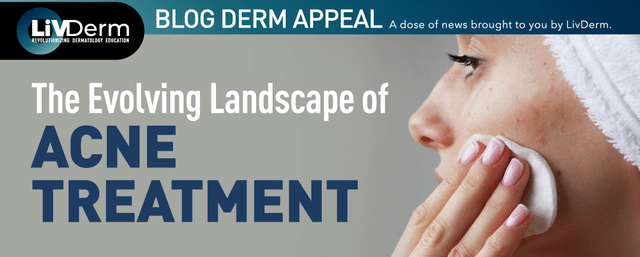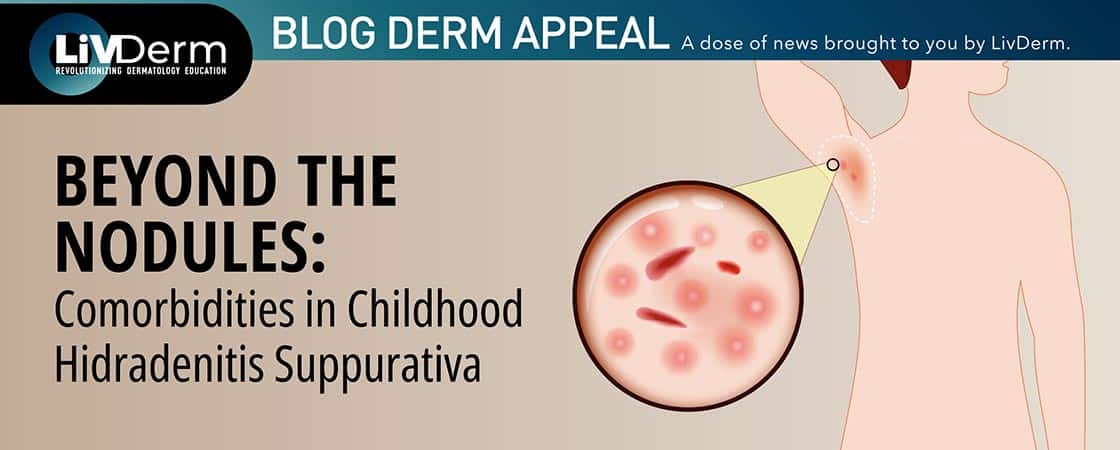The treatment landscape for acne vulgaris continues to expand and evolve, increasing the number of available options for dermatologists and their patients suffering from acne. Depending on the type, severity, lifestyle, and individual preferences of a patient, a dermatologist may prescribe oral or topical antibiotics, or creams and ointments. As with any medication, it is necessary to weigh the risks and benefits for each prior to beginning a treatment regime. Nevertheless, as more research continues into the therapies already available as well as what’s in the pipeline, scientists and researchers are gaining a better and more comprehensive understanding of how some of these medications work. This will further guide clinicians on the best and most appropriate therapies to prescribe to their patients.
The Acne Toolbox
In finding the best treatment for acne, clinicians look to target the four pillars of acne pathogenesis: excess sebum production, follicular epidermal hyperproliferation, inflammation, and propionibacterium acnes. During an expert forum featuring Hilary E. Baldwin, MD, Joshua Zeichner, MD, FAAD, Zoe Diana Draelos, MD, Aaron S. Farberg, MD, and Leon H. Kircik, MD, Dr. Baldwin stated, “It’s not a linear relationship or that one necessarily leads to the other. I like to say it’s a very incestuous relationship between the four different factors, each one of them feeding into the other.”
Many clinicians are now turning to oral antibiotics as a first-line therapy for acne and several other chronic inflammatory skin disorders. But with these decisions, it is vital that they are aware of the accompanying research and guidelines about how to use antibiotics effectively and responsibly. It is well-known that prolonged or repeated use of oral antibiotics runs the risk of antibiotic resistance. It is also the case that they can have a significant negative impact on the skin and gastrointestinal microbiomes which can lead to dysbiosis. Ivan B. Lomakin, PhD, associate research scientist at Yale School of Medicine, explains that when doctors prescribe broad-spectrum antibiotics, it doesn’t just harm the pathogen, but the good bacteria too. He adds that “Data shows that if you use broad-spectrum antibiotics even for short periods of time, it can take as long as two years for your gastrointestinal microbiome to recover.”

Speaking recently about narrow-spectrum antibiotics, Christopher G. Bunick MD, PhD, associate professor of dermatology at Yale School of Medicine and South Beach Symposium Planning Committee Member, stated, “It is my personal opinion [that] we write so [many prescriptions for] tetracycline antibiotics and doxycycline that it is essential that dermatologists know tetracycline antibiotics for the safety of our patients, for the health of our patients, and so that we can be competent physicians.”
Sarecycline: The Latest Breakthrough Study
Sarecycline, a third-generation tetracycline-class antibiotic, has been found to work differently than other tetracycline-class antibiotics for treating acne vulgaris. Not only does it have a strong specificity for one bacterium, but also it shows a low propensity for developing antibiotic resistance.
In the recent study conducted by Dr. Bunick, Dr. Lomakin, Swapnil C Devarkar, PhD, Shivali Patel, PhD, and Ayman Grada, MD, MS, the team looked to evaluate sarecycline’s ability to inhibit protein translation in Cutibacterium acnes (C. acnes) 70S ribosome using a two-site mechanism. In doing so, they found that sarecycline binds to two active sites on the ribosome, not just one. The fact that there are two active sites where sarecycline is functioning on the C. acnes means that if there is a ribosomal mutation in one site, that’s not going to be enough to create antibiotic resistance. Based on the scientific data from this study, Dr. Bunick states that a dual-site mutation would be needed in order to create antibiotic resistance with sarecycline.
“This is very profound because it means, or at least it explains partly, why we have this narrow-spectrum agent that might give us a real step forward or advancement in practicing antibiotic stewardship in dermatology.”
Dr. Bunick
Clascoterone Cream 1%
Clascoterone Cream 1%, a topical androgen receptor inhibitor, was approved by the U.S. Food and Drug Administration in August 2020 and targets sebum production driving inflammation and overgrowth of C acnes. The randomized clinical trials of 1440 patients revealed that patients with acne treated with clascoterone cream 1%, experienced greater treatment success when compared to treatment with vehicle. Furthermore, there were considerable reductions in absolute non inflammatory and inflammatory lesion counts. Clascoterone was deemed efficient and safe with low adverse event rates.
Dr. Baldwin reveals, “The addition of clascoterone into our acne toolbox is something that I was personally looking forward to for many years. We’ve been looking for a topical sebum inhibitor so that we could treat our patients entirely with topical therapy.”
She went on to explain that prior to the introduction of clascoterone, the only method of decreasing sebum production in patients was by using oral medications which included spironolactone, oral contraceptives, and isotretinoin.

She added that as spironolactone and oral contraceptives were only for use in female patients, that meant the only option for males was oral isotretinoin, for which not all patients are candidates. According to Dr. Baldwin therefore, “the introduction of this product was a big deal. It was a way that we could treat men, treat all four pillars of acne pathophysiology in our male patients, as well as our female patients.”
IDP-126
IDP-26, a novel treatment that combines an antibiotic, an antibacterial, and a retinoid, is a fixed dose triple combination of clindamycin 1.2% plus benzoyl peroxide 3.1% and adapalene 0.15%. In a Phase II, double-blind, multicenter, randomized trial of 741 participants, it was revealed that at week 12, 52.5% of participants achieved treatment success with IDP-126 compared to vehicle (8.1%) and dyads (range 27.8–30.5%; P ≤ 0.001, all). The study concluded that overall, IDP-26 demonstrated significantly greater efficacy over vehicle and was well tolerated over a 12-week period, making it a potential new treatment option in the acne armamentarium.
Speaking of IDP-26, Lawrence F. Eichenfield, MD, chief of pediatric and adolescent dermatology at Rady Children’s Hospital in San Diego, stated, “If approved, we probably will be able to decrease our need for systemic therapies in some individuals.”

Clinical professor of dermatology at Indiana University Medical Center Icahn School of Medicine and LiVDerm Advisory Board Member, Dr. Kircik, believes IDP-26 to be “the most exciting agent in the pipeline…and it’s going to be a very, very unique product that we expect to hit every aspect of acne treatment.”
Isotretinoin
According to Dr. Zeichner, isotretinoin is indicated for patients with severe nodular cystic acne or those resistant to traditional treatment, and patients with physical or emotional scarring.
During the aforementioned expert forum, Dr. Zeichner mentioned that clinicians are now reaching for isotretinoin much earlier now than they did 10 years ago. He believes this to be because of an increased understanding of both the safety and effectiveness of the drug. Dr. Baldwin seconded this statement, adding, “We’re not afraid of isotretinoin anymore. There was a period when we were. There was a time when we weren’t using it because iPLEDGE was so difficult to utilize. And I think we’ve come past that now. We recognize it for the wonderful drug that it is. And we celebrate its 40th birthday with it still being the best medication that we have to treat our severe acne patients.”
There are challenges in prescribing isotretinoin, however, one being the ability to reach target absorption. As it is meant to be administered along with a high-fat, high-calorie meal, this can present a problem for many who skip meals or do not consume the adequate amount of calories.
“I always say vehicle matters in topical treatments and then delivery matters in systemic treatments. So it doesn’t matter how much of a drug you’re getting, if it’s not absorbed, it’s absolutely useless.”
Dr. Kircik
During the recent Acne Boot Camp Session presented at the American Academy of Dermatology 2023 Annual Meeting, Dr. Zeichner referred to two new formulations of isotretinoin designed to combat the absorption issue. The first, lidose isotretinoin, makes use of a technology called hot melt extrusion which enhances the solubility from a lipid matrix. It has the effect of boosting absorption regardless of whether the patient has eaten a high-fat meal. The second is micronized low-dose isotretinoin which reduces the size of the drug particles to micrometer size, boosting the drug dissolution rate.
“It’s an exciting time to be a dermatologist treating acne because we have innovation in both the topical and systemic space to give our patients novel treatments that are both safe and effective, ultimately improving quality of life."
Dr. Zeichner
Concluding Thoughts
In addition to the available therapies for acne, one of the most important aspects of the treatment and management of the condition is a good relationship between the patient and the dermatologist. According to Dr. Farberg, “Finding the correct, personalized treatment for each patient is very important. That communication is critical to selecting and maintaining the right treatment pathway for each patient.”
Dr. Draleos adds that one of the biggest challenges in acne treatment is compliance. She states, “I think it’s really important that you pick a medication that suits the person’s personality and their lifestyle and they’re inclined to use it.”
- Frontline Forum: Expert Perspectives On Acne Management https://cdn.sanity.io/files/0vv8moc6/dermatologytimes/575e1eabb0b0c944ac7e7d9a106db4c45bcddc39.pdf/DT0323supp_ezine.pdf
- https://www.dermatologytimes.com/view/narrow-spectrum-antibiotics-the-precision-medicine-of-acne-
- https://www.dermatologytimes.com/view/christopher-bunick-md-phd-previews-recently-published-sarecycline-study-to-be-presented-at-aad
- https://medicine.yale.edu/news-article/antibiotics-for-acne-groundbreaking-study-shows-why-one-works-best/
- https://www.dermatologytimes.com/view/expert-perspectives-on-a-recent-approval-in-acne-management
- https://www.dermatologytimes.com/view/acne-update-2022-s-top-5-trends
- https://jamanetwork.com/journals/jamadermatology/fullarticle/2765025
- https://link.springer.com/article/10.1007/s40257-021-00650-3
- https://www.mdedge.com/dermatology/article/260427/acne/topical-treatment-options-acne-continue-expand
- https://www.dermatologytimes.com/view/isotretinoin-best-practices-new-formulations-avoiding-relapses
- https://www.dermatologytimes.com/view/leon-kircik-md-faad-evolving-acne-arsenal

















